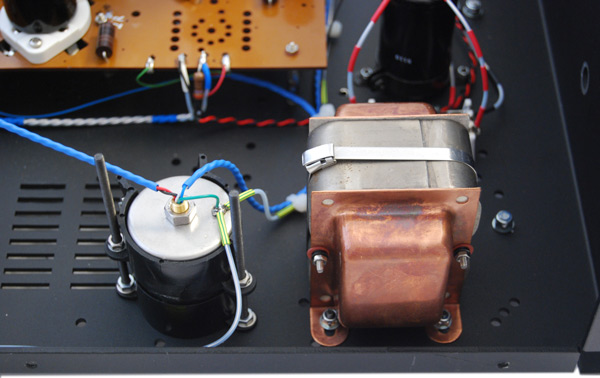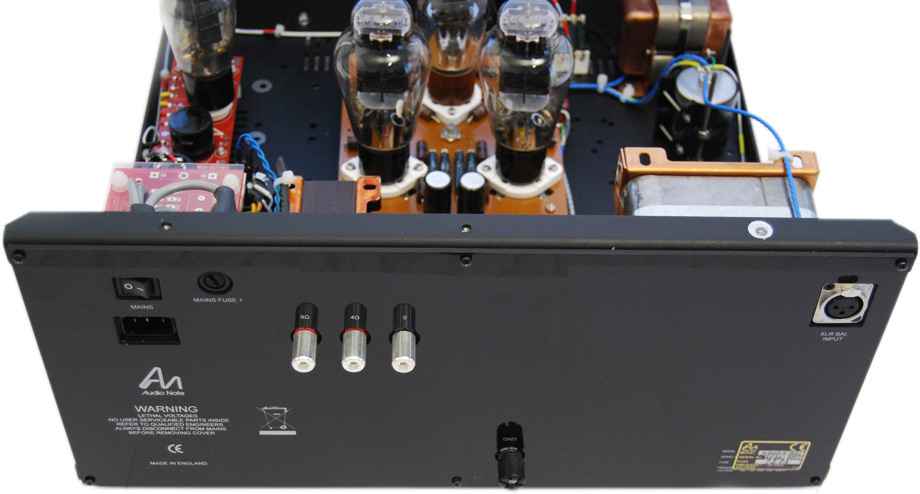Treble and Midrange
The Triolon Excalibur’s top-end above 6000 Hz as driven by the Kegon Balanced is nicely extended without any brightness or grit, particularly in the reproduction of cymbals and other metallic struck instruments. Tonality is always spot on.
The top-end of the KBs is more natural and relaxed than that of the other amps and certainly more harmonically and timbrally detailed. The midrange is also improved. The mids and highs of the KBs have much more energy and life without any brightness or “peakiness”. The KBs are in many areas a rather distinct improvement over the solid-state monoblocks: much more energy in the midrange and lower treble, warmer, a richer, more complex tonal palette with greater texture and nuance and the ability to give singers/instruments a three-dimensional body.
You don’t just hear the attack and the top-end of an instrument, although the KBs are superb in both areas. You hear the full harmonic envelope without an undue emphasis on any one part. The KBs are particularly good in reproducing string tone and the woodiness of certain instruments. This is especially true in the reproduction of massed strings – one of the most difficult sounds to reproduce without grain or smear, and, in choral works. In the past, I would have said that there was a tradeoff in using silver wire, enhancing detail and leading edge definition, but at the expense of some brightness and a thinning of the mid-bass and lower treble; I would typically have preferred the tradeoffs associated with the use of copper wire with less detail, softer leading edge but warmer-sounding. However, somewhat to my surprise, these negative characteristics do not occur with the KBs, which seem to offer the best of both worlds.
Break-In and Power Limitations
More than most, these amps require prolonged break-in and prolonged warm up. Like all Audio Note gear, they need to be on for a few days to sound their best. With respect to warm up, the KBs require a minimum of about an hour (which will give you about 80% of what they are capable of doing) and continue to improve very gradually over the course of the next three days. In many instances, I turn them on after work on Friday and leave them on during the weekend until Sunday night.
With respect to break-in, the KBs were extremely musical initially, but were somewhat bloomy in the bottom, softened transients, a bit thin in the mids and at times certain instruments tended to localize on the horns off and on during the first 600 hours. Fortunately, during this time, each of these break-in artifacts manifested itself off and on but never all at the same time.
As I commented earlier, these amps do a phenomenal job of driving the Triolons, even above the listening levels at which I listen (peaks around 90-93 dB but average sound pressure levels at 76-78 dB); however, they can be driven into clipping at extreme volume levels. While they never sound unmusical, at clipping, certain frequencies did localize on the horns rather than occupying their normal place in the soundstage. At a certain point, it is difficult to tell whether the amps are clipping or whether the room or speakers are being overdriven.
Comments
Who would have thought changing a single piece of equipment in my system could have made such a dramatic difference? Even prior to full break-in, I slowly began to invite audio friends over for early listening so that they could help track changes to the sound as the amps broke-in. I think that it would be fair to say that the general reaction has been quite favorable. All have commented on the significant improvement to the upper bass, the midrange and the lower treble. This is not to say that any feel that the solid-state designs were not good, but rather that tubes when properly used are much better at recreating certain aspects of the music.
The two other comments that seem to surface with some regularity are: 1) the level of transparency (in many instances, those who bring their own favorite software respond that they are hearing information that they previously had missed); and 2) “I never realized that this CD had so much bass.” In one case, a female audiophile who plays violin brought an older recording of Etta James which she had felt was unlistenable on another system and found it quite lovely.
The KBs have never lacked bass energy but did initially sound a bit bloomy. Although part of the change was related to break-in, bass improved dramatically when Finite Element Cerabases were inserted between each amplifier and the Finite Element Pagode Reference amp stands on which the KBs were positioned. The other area which has changed has been the midrange. It seems to be getting richer and slightly warmer with additional break-in. These comments should be taken in the context that the KBs do not fit the typical stereotype of a direct-heated triode amplifier. Think instead of neutrality, extreme transparency and extension at the frequency extremes. I know that it has become cliché to say that “I hear things from familiar recordings that I have never heard on other equipment,” but in this case, it would be true.
It is probably worth commenting that this was in the context of a system which was already highly resolving: Rockport Sirius TT, Lyra Titan i, Einstein phonostage and preamp, Jorma Prime cabling. I was listening to “Orange Lady” on Weather Report’s same titled album last night on vinyl. Keep in mind this was a pressing purchased at a local used record store and not some audiophile pressing. This turned out to be a particularly outstanding demonstration disk in that it contains a wealth of percussion instruments, is very complex and is one of those records that can image outside the walls of your listening room. There is a percussion instrument , the clave, which consists of hollow wooden blocks at different pitches. With most electronics, when the claves are struck, you hear the initial click but not always the complex harmonic overtones. With the KBs, you hear both which results in a very different perception of the sound. I think that when I say that the KBs are transparent in a way that few other amps can manage, it is both in the low-level detail and its ability to preserve the harmonic and dynamic envelopes around instruments.
Funny, but Saturday is often the night that friends come over to listen. Recently, an acquaintance was kind enough to bring ten or twelve CDs over so that we could listen to a few outstanding/challenging tracks from each. The session was more interesting than is often the case as many of the tracks were unfamiliar and helped clarify some of my thoughts about the sound of the system in its current configuration.
If there were ever two pieces of equipment that were made for each other, it was the Acapella plasma tweeter and the balanced Kegons. This is particularly clear with respect to the reproduction of cymbals and snare drums which have to be the most lifelike that I have ever heard in an audio system. The combination does a superb job of capturing the initial strike as well as the prolonged decay of the cymbals. Likewise, the initial strike of a snare drum or rim shot is reproduced in a manner that will literally cause you to jump. Strangely enough, the KBs are also doing an excellent job of controlling the four 10″ SEAS woofers in each of the Triolon Excalibur bass columns. Bass control, extension and dynamics are excellent.
Again, who would’ve thought a 23-watt SET is capable of this degree of dynamics and control?
- ← Previous page
- (Page 4 of 4)



Nice Review!
I never understood why AN put the Kegon Balanced and I believe Kageki Balanced too in a unattractive cube box instead of using something more like the Gaku-On box.
Cheers!
geht mir auch so.ich hatte bis Gestern die gakuon verstärker und seit heute die 300B Kegon
der Klang ist fantastisch.Schade das sie so verkleidet sind.
I feel the same way. I had the Gakuon amplifier until yesterday and since today the 300B Kegon
the sound is fantastic, it’s a shame they are so disguised.
Hans,
Greetings. I purchased the review samples and continue to use it in my system. Both the Balanced Kegons and the Gakuons are Level 5/6 Audio Note products so one might think that they sound alike with the Gakuon having more power; however, they sound very different due to the difference in output tubes (300B vs. 211). Each tube has a very distinct sound, particularly if the 300B used is a 1970’s or earlier Western Electric and the 211 is a vintage GE. I would be curious about your thoughts as you have owned both. What output tubes are you using and what is the rest of your system? I am still using Acapella Triolon speakers.
Fred